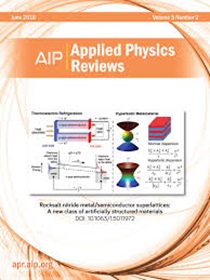超导电流的栅极控制:机制、参数和技术潜力
IF 11.9
1区 物理与天体物理
Q1 PHYSICS, APPLIED
引用次数: 0
摘要
在传统的金属氧化物半导体(CMOS)电子器件中,器件的逻辑状态是由栅极电压(VG)设定的。这种效应的超导等效物一直不为人所知,直到最近的研究表明,栅极电压可以调节流经超导体中纳米收缩的超导电流(超级电流)。这种栅极控制的超电流(GCS)可以产生与 CMOS 逻辑类似的超导逻辑,但能量耗散更低。然而,GCS 的物理机制仍存在争议。在这篇综述文章中,我们将根据所报道的证据,说明为 GCS 提出的主要机制,以及对其影响最大的材料和器件参数。我们的结论是,在迄今为止所报道的不同研究中,有不同的机制在起作用。然后,我们概述了有助于回答有关该效应的未决问题并实现对其控制的研究,这对应用至关重要。最后,我们深入探讨了 GCS 对采用低能量耗散和量子技术的高性能计算的影响。本文章由计算机程序翻译,如有差异,请以英文原文为准。
Gate control of superconducting current: Mechanisms, parameters, and technological potential
In conventional metal-oxide semiconductor (CMOS) electronics, the logic state of a device is set by a gate voltage (VG). The superconducting equivalent of such effect had remained unknown until it was recently shown that a VG can tune the superconducting current (supercurrent) flowing through a nanoconstriction in a superconductor. This gate-controlled supercurrent (GCS) can lead to superconducting logics like CMOS logics, but with lower energy dissipation. The physical mechanism underlying the GCS, however, remains under debate. In this review article, we illustrate the main mechanisms proposed for the GCS, and the material and device parameters that mostly affect it based on the evidence reported. We conclude that different mechanisms are at play in the different studies reported so far. We then outline studies that can help answer open questions on the effect and achieve control over it, which is key for applications. We finally give insights into the impact that the GCS can have toward high-performance computing with low-energy dissipation and quantum technologies.
求助全文
通过发布文献求助,成功后即可免费获取论文全文。
去求助
来源期刊

Applied physics reviews
PHYSICS, APPLIED-
CiteScore
22.50
自引率
2.00%
发文量
113
审稿时长
2 months
期刊介绍:
Applied Physics Reviews (APR) is a journal featuring articles on critical topics in experimental or theoretical research in applied physics and applications of physics to other scientific and engineering branches. The publication includes two main types of articles:
Original Research: These articles report on high-quality, novel research studies that are of significant interest to the applied physics community.
Reviews: Review articles in APR can either be authoritative and comprehensive assessments of established areas of applied physics or short, timely reviews of recent advances in established fields or emerging areas of applied physics.
 求助内容:
求助内容: 应助结果提醒方式:
应助结果提醒方式:


